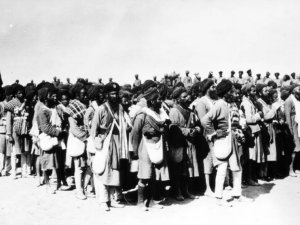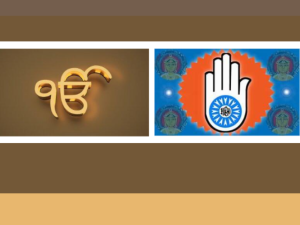Karuna (Compassion) is a foundational principle in Sikh teachings, transcending beyond a mere virtue to become a fundamental way of life. Sikh dharmic tradition, founded by Guru Nanak in the 15th century, emphasizes selfless service, equality, and justice, with compassion being a driving force behind all these ideals. The teachings of the Sikh Gurus consistently reinforce the necessity of kindness, humility, and service to humanity. This article explores the profound role of compassion in Sikh philosophy, its integration into daily life through practices like Langar and Seva, and the Gurus' exemplary leadership in fostering compassion. The principles of Sikh compassion extend beyond religious boundaries, encouraging universal humanitarianism. In an age marked by materialism and division, the Sikh approach to compassion offers a timeless and practical guide for fostering global harmony and social responsibility.
Introduction
Karunā (Compassion) refers to a deep sense of mercy, compassion, and kindness toward all living beings. It involves not only feeling empathy but also acting to alleviate the suffering of others. It is among the highest virtues emphasized in various religious and philosophical traditions [1-4]. However, in Sikh Dharmic tradition, it is not just a recommended quality but a necessity that defines the essence of the faith. Guru Nanak, the founder of the Sikh Dharmic tradition, laid the foundation of a religion that places immense importance on selfless service, love, and universal brotherhood. The Sikh concept of "Karuna" (compassion) is deeply intertwined with "Sarbat da Bhala"—the welfare of all—underscoring the belief that true spirituality is incomplete without active kindness and service to others [4-8].
The Sikh Gurus exemplified compassion through their teachings and actions. Guru Nanak rejected caste divisions and emphasized equality, while Guru Arjan Dev and Guru Tegh Bahadur sacrificed their lives for religious freedom and justice. The institutionalization of Langar (community kitchen) and Seva (selfless service) in gurdwaras worldwide is a testament to the living spirit of compassion in Sikh dharmic tradition [9-13]. These practices ensure that no one goes hungry, and that help is provided to those in need, regardless of their background.
In contemporary times, Sikhs continue to uphold these values by engaging in global humanitarian efforts, providing aid during crises, and standing against social injustices [14-20]. The Sikh philosophy of compassion is a call to action that extends beyond religious devotion—it is a model for creating a more equitable and compassionate world. This article delves into the significance of compassion in Sikh dharmic tradition, illustrating how it shapes the lives of its followers and influences broader society.
Compassion: A Divine Virtue in Sikhism
Compassion holds a fundamental place in Sikhism, deeply rooted in the belief in Ik Oankaar, the one eternal God who embodies endless virtues. Sikhs recognize God as "ਕਰੁਣਾਪਤੇ" (Karunapate - the master of compassion), "ਦਇਆਲ" (Dayal - the compassionate one), "ਮਿਹਰਵਾਨੁ" (Meharvan - the merciful), and "ਕਿਰਪਾਲ" (Kirpal - the kind-hearted) [5-8]. These divine attributes emphasize that compassion is not merely a virtue but a reflection of the Divine presence itself.
The Sikh Gurus encouraged their followers to imbibe these God-like qualities in their daily lives. By practicing compassion, Sikhs align themselves with the divine will (Hukam) and uphold the teachings of Sri Guru Granth Sahib. Compassion enables Sikhs to care for those who are suffering, extend kindness to the less fortunate, and foster a sense of unity and brotherhood within the community. Acts of seva (selfless service), a core Sikh practice, reflect this compassionate spirit. Langar (the free community kitchen) is a perfect example where no one is discriminated against, and all are served with love and equality.
Compassion in Sikhism transcends emotion; it is an active force driving Sikhs to engage in social justice, uplift the oppressed, and create a harmonious society. By embodying compassion, Sikhs strive to reflect the Divine nature of Ik Oankaar in their thoughts, words, and actions.
The Foundational Role of Compassion in Sikh Dharmic Tradition
Sikh Dharmic tradition teaches that true spirituality cannot be achieved without compassion. Guru Nanak, the first Sikh Guru, emphasized that devotion to God is meaningless if it does not translate into kindness towards others. His teachings rejected hollow rituals and instead encouraged a path of righteousness centred on love and empathy. The foundational text of Sikh Dharmic tradition, the Guru Granth Sahib, repeatedly highlights the importance of compassion, reminding Sikhs that spiritual progress remains incomplete without it.
Guru Nanak’s philosophy emphasized that compassion must manifest in actions, not just thoughts or words. This is encapsulated in the Sikh concept of "Sarbat da Bhala," which means "the welfare of all." The core of the teachings of Guru Nanak are naam japna (remembrance of the Name of God), kirt karni (honest labour) and wand chhakna (sharing of the earnings). He proclaims:
ਘਾਲਿ ਖਾਇ ਕਿਛੁ ਹਥਹੁ ਦੇਇ ॥ ਨਾਨਕ ਰਾਹੁ ਪਛਾਣਹਿ ਸੇਇ ॥
He, who earns his living by honest labour and shares his earnings with others, has discovered the path of righteousness, says Nanak. (M. 1, p. 1245)
These principles encourage Sikhs to work not only for their own benefit but for the well-being of the entire world [21-22].
Compassion - One of the Five Essential Virtues
The Sikh Dharmic tradition identifies five key virtues that a Sikh must cultivate: Sat (truth), Santokh (contentment), Karuna (compassion), Nimrata (humility), and Pyaar (love). Karuna is regarded as one of the most crucial because it fosters a deep connection with humanity and aligns one’s actions with divine will. Sikhs are Guru Arjan Dev encourages us to adorn these virtues. He proclaims:
ਸਤੁ ਸੰਤੋਖੁ ਦਇਆ ਧਰਮੁ ਸੀਗਾਰੁ ਬਨਾਵਉ ॥
Make truth, contentment, compassion, and righteousness your adornments. (M. 5, p. 812)
In Sikh theology, compassion is not merely an abstract concept but a guiding force that directs a person towards righteousness. It is believed that a compassionate heart is a purified heart, and only those who develop this virtue can indeed walk on the path of righteousness. This quality is strongly advocated in the Sikh Dharmic tradition, where practitioners are encouraged to embody compassion in their relationships and to show mercy to those who have wronged them. This emphasis on compassion differentiates Sikh Dharmic tradition from faiths that might prioritize ritual over humanitarian action.
Sri Guru Granth Sahib (SGGS) exhorts people to be forgiving, considerate and compassionate [23-24]. It enunciates:
ਇਕੁ ਫਿਕਾ ਨ ਗਾਲਾਇ ਸਭਨਾ ਮੈ ਸਚਾ ਧਣੀ ॥ ਹਿਆਉ ਨ ਕੈਹੀ ਠਾਹਿ ਮਾਣਕ ਸਭ ਅਮੋਲਵੇ ॥
Do not utter even a single impolite word to anyone, as the true Master abides in all. Do not break anyone’s heart; each heart is a priceless jewel. (Shaikh Farid, p. 1384)
Advocating the maxim of ‘Parenthood of God and Fellowship of Humankind,’ SGGS proclaims:
ਫਰੀਦਾ ਖਾਲਕੁ ਖਲਕ ਮਹਿ ਖਲਕ ਵਸੈ ਰਬ ਮਾਹਿ॥ ਮੰਦਾ ਕਿਸ ਨੋ ਆਖੀਐ ਜਾਂ ਤਿਸੁ ਬਿਨੁ ਕੋਈ ਨਾਹਿ॥
The Creator dwells in His Creation, O Farid! And the Creation in the Creator. Whom can we call unworthy when there is none without Him? (M. 5, p. 1381)
The Role of Guru Nanak and Other Sikh Gurus in Exemplifying Compassion
The lives of Sikh Gurus serve as powerful testimonies to the importance of compassion. Guru Nanak set the foundation by rejecting social divisions, reaching out to the marginalized, and establishing the practice of "Langar"—the community kitchen that serves free meals to all, regardless of caste, religion, or background. This tradition continues today in Sikh gurdwaras worldwide, demonstrating the living embodiment of compassion in Sikh practice. Guru Angad, the second Guru, promoted physical well-being and care for others by establishing schools and hospitals, reinforcing the idea that serving humanity is akin to serving God.
Guru Amar Das, the third Guru, institutionalized Langar and fought for gender equality, showing compassion toward women in a society that often discriminated against them. Sati, meaning "a virtuous woman" or "one who is true to her husband," was a historical funeral custom practiced in some parts of India, where a widow would immolate (burn) herself on her deceased husband's funeral pyre [25].
In Hindu mythology, the term Sati originally referred to Goddess Sati, the wife of Lord Shiva, who immolated herself in protest of her father’s insult toward her husband. Over time, this story was misinterpreted to justify a widow’s self-immolation. While ancient Hindu texts such as the Rigveda make no mention of Sati as a required practice, some medieval texts like the Padma Purana and Garuda Purana mention it as an ideal form of devotion — though not as a compulsory act [25].
The practice of Sati is believed to have emerged in certain Hindu communities, particularly among warrior castes (like Rajputs) and some elite classes, where ideas of honour, loyalty, and family pride were emphasized. Sati became a common part of the 13th century in India because of the written religious texts of Hindus, such as the Mahabharata and Puranas, which mentioned and talked about sati. This practice was at its peak in the 14th and 15th centuries, when it became a significant social issue that attracted considerable attention in Indian history. Guru Amar Das (1479-1574), the third Sikh Guru, strongly disapproved of this practice of Sati. His hymns reflect Sikhism’s firm rejection of this oppressive practice. He proclaimed:
ਸਤੀਆ ਏਹਿ ਨ ਆਖੀਅਨਿ ਜੋ ਮੜਿਆ ਲਗਿ ਜਲੰਨੑਿ॥ ਨਾਨਕ ਸਤੀਆ ਜਾਣੀਅਨੑਿ ਜਿ ਬਿਰਹੇ ਚੋਟ ਮਰੰਨੑਿ ॥
Those are not called 'sati' who burn themselves on the funeral pyre. Nanak says true 'sati' are those who endure the pangs of separation and die in that pain. (M. 3, p. 787)
This powerful verse by Guru Amar Das addresses the practice of Sati and strongly rejects this ritual. Instead, it offers a profound spiritual interpretation of what it means to be a true "Sati."
This verse powerfully reminds us that true love and devotion are not proven through destructive rituals but through inner strength, deep emotional connection, and a profound yearning for the beloved, whether human or divine. Guru Amar Das’s teachings played a pivotal role in challenging harmful social practices like Sati and Parda (veil) and advocating for the dignity and empowerment of women.
It is pertinent to add that the practice of ‘Sati’ faced strong opposition from reformers like Raja Ram Mohan Roy, who played a significant role in convincing the British colonial government to ban Sati. In 1829, Lord William Bentinck, then Governor-General of India, formally outlawed Sati under British India’s Sati Prohibition Act. Despite the ban, isolated cases persisted in rural areas, prompting the introduction of stricter laws like the Sati Prevention Act of 1987, which criminalized the act and its glorification [26].
Guru Arjan Dev, the fifth Guru, exemplified compassion in his martyrdom. He accepted suffering with grace and forgiveness, setting a precedent for Sikhs to respond to cruelty with resilience rather than revenge. Later, Guru Tegh Bahadur sacrificed his life to protect religious freedom, not just for Sikhs but for Hindus who faced oppression. His compassion was so profound that he laid down his life for the rights of others to practice their faith freely.
The tenth Guru, Guru Gobind Singh, continued this tradition by creating the Khalsa, a community of saint-soldiers who were both warriors and protectors of the downtrodden. While they were trained in self-defence, their role was not of aggression but of compassionate service to humanity.
Compassion in Sikh Practices and Daily Life
Sikh dharmic tradition is unique in its emphasis on practical compassion. Instead of limiting compassionate acts to specific religious rituals or occasions, Sikhs are encouraged to integrate them into their daily lives. Some of the keyways this is done include:
- Langar (Community Kitchen): The practice of Langar is one of the most profound expressions of compassion in the Sikh Dharmic tradition. Every gurdwara (Sikh temple) offers free meals to anyone in need, reinforcing the belief that no one should go hungry. Volunteers prepare and distribute food, embodying the Sikh ideal of Seva (selfless service).
- Seva (Selfless Service): Seva is integral to Sikh Dharmic tradition. It can take many forms, from serving food in Langar to helping the sick, cleaning gurdwaras, or helping in times of crisis. Sikhs believe that serving others is equivalent to serving God, making Seva a vital spiritual practice.
- Kirat Karni (Earning an Honest Living): Compassion in Sikh dharmic tradition is not just about charity but also about justice and ethical living. Sikhs are taught to earn their livelihood through honest means and to use their earnings to help others. This ensures that wealth is not accumulated selfishly but shared for society's betterment.
- Vand Chakna (Sharing with Others): Sikhs are encouraged to share their earnings with those in need, embodying the principle of communal support. The idea is that wealth should not be hoarded but used to uplift others, ensuring that society as a whole thrives.
- Protecting the Oppressed: Sikh history is full of examples where Sikhs have stood up for the downtrodden. The Gurus emphasized that compassion must also extend to fighting injustice. Guru Gobind Singh’s Khalsa was created to protect those who could not defend themselves, demonstrating that genuine compassion sometimes requires taking a stand against oppression.
The Contemporary Relevance of Sikh Compassion
Even in modern times, Sikhs continue to embody compassion through global humanitarian efforts. Whether it is setting up relief camps during natural disasters, providing aid to war victims, or establishing free medical camps, Sikh organizations such as Khalsa Aid [15] and United Sikhs [18] around the world actively work to alleviate suffering.
One remarkable example is how Sikh communities responded during the COVID-19 pandemic [27-28]. Gurdwaras around the world provided food, shelter, and medical aid to those affected, regardless of religion or background. Similarly, in times of war or displacement, Sikhs have stepped forward to offer aid, exemplifying the spirit of "Sarbat da Bhala."
Compassion Beyond Religion: A Universal Message
While compassion is a core tenet of Sikh Dharmic tradition, it is not confined to Sikhs alone. The Gurus emphasized that humanity is one, and kindness should be extended to all, regardless of faith, caste, or nationality. Sikh Dharmic tradition’s emphasis on universal fellowship of humankind and equality makes its teachings of compassion relevant to people of all backgrounds. Guru Nanak proclaims:
ਸਭ ਮਹਿ ਜੋਤਿ ਜੋਤਿ ਹੈ ਸੋਇ ॥ ਤਿਸ ਦੈ ਚਾਨਣਿ ਸਭ ਮਹਿ ਚਾਨਣੁ ਹੋਇ ॥
The Divine Light is present in all; Through that Light, all are illuminated. (M. 1, p. 13)
This verse emphasizes the unity and interconnectedness of all existence. The "Jot" (Divine Light) refers to the divine essence or spark that resides within every being. Guru Nanak's teachings highlight that this light transcends boundaries of caste, creed, and social status — the same universal light pervades everything [29-30]. The second line reflects that just as light dispels darkness, the awareness of this divine presence brings enlightenment and wisdom to all. It promotes equality, reminding us to see divinity in every soul and to treat others with compassion and respect.
Guru Nanak’s message of oneness, "Ek Oankaar," reminds us that God resides in all beings, and harming another is akin to hurting oneself [5]. This philosophy aligns Sikh compassion with a broader humanitarian approach, making it a guiding principle not just for Sikhs but for all of humanity.
Conclusion
Compassion in Sikh Dharmic tradition is not a passive or abstract concept but an active and essential way of life. It is embedded in the core teachings of the Sikh Gurus and is reflected in practices like Seva and Langar, which ensure that no one is left hungry or neglected. The Sikh principle of "Sarbat da Bhala," working for the welfare of all, exemplifies how compassion extends beyond individual acts of kindness to a larger vision of social justice and humanitarianism.
The legacy of the Sikh Gurus, who lived and sacrificed for the ideals of compassion, continues to inspire Sikhs today. Whether through charitable efforts, disaster relief, or standing against oppression, Sikhs worldwide actively practice the values imparted by their faith. The COVID-19 pandemic, for instance, saw Sikh communities mobilizing to provide food, medical aid, and shelter, reinforcing that compassion is not just a teaching but an ongoing responsibility.
In a world facing increasing social divisions and crises, the Sikh ethos of compassion provides a practical and enduring solution. By embracing selflessness, empathy, and service to others, the Sikh Dharmic tradition offers a blueprint for a more just and harmonious society. The teachings of Guru Nanak and his successors remind us that true spirituality is found not in rituals but in the everyday acts of kindness and sacrifice that uplift humanity. As the world navigates challenges of inequality and suffering, the Sikh way of compassion stands as a timeless and powerful guide to creating a more inclusive and caring world.
References
- What is Compassion (Karuna) in Buddhism? (n.d.). Lion’s Roar.
- Jain, P. (2019). An Introduction to Jain Philosophy. New Delhi, India: D. K. Printworld (P) Ltd.
- Long, J. D., Miller, C. P., & Reading, M. (Eds.). (2019). Beacons of Dharma: Spiritual Exemplars for the Modern Age. Lexington Books, USA.
- Nanda, Ved P. (Ed.), (2016). Compassion in the 4 Dharmic Traditions: Exploring Empathy in Religions. Prabhat Prakashan. New Delhi. ISBN: 9789351867364
- Sri Guru Granth Sahib. (1983). Reprint, S. G. P. C., Amritsar. India. 1-1430.
- Singh, Sahib. (n.d.). Guru Granth Darpan.
- Khalsa, Sant Singh (n.d.). English translation of SGGS.
- Search Gurbani. (n.d.). https://www.searchgurbani.com/
- Singh, R. (2022, April 1). Compassion – The Human Trait. SikhNet. USA.
- Cultivating Compassion Through Sikh Teachings (2025, Jan. 29). Reality Pathing.
- Compassion - Forgiveness is Divine (n.d.). Sikh Research and Education Center.
- Lal, Harbans. (2015, Sept. 25). Compassion and Perseverance: Two Sikh Values Upheld by Bhagat Puran Singh. Seeking Wisdom- A Blog by Dr. Harbans Lal.
- Grewal, Dalvinder Singh. (2025, March 3). Compassion: An Essential Ingredient for social survival. Sikh Philosophy Network. Chandigarh. India.
- Singh, E., Singh, D. P. (2022, June). Role and Relevance of Gurudwaras in Global Context - An Interview. The Sikh Review. Kolkata. India. 70 (6). 49-59.
- Singh, H. (2022). Khalsa Aid: A Legacy of Humanitarian Service. Khalsa Aid International. URL: khalsaaid.org
- Pingalwara, Amritsar, Punjab. India, (1947). https://pingalwara.org/
- Ravi Singh Khalsa: Rekindling Hope in Humanity. https://www.sikhnet.com/news/ravi-singh-khalsa-rekindling-hope-humanity
- United Sikhs. (2022). Global Civil Rights Advocacy and Humanitarian Work. United Sikhs. URL: unitedsikhs.org
- Sikh Youth Australia. (2023). Empowering Sikh Youth: Programs and Initiatives. Sikh Youth Australia. URL: sikhyouthaustralia.org
- Sikh Coalition. (2021). Advocacy and Civil Rights for Sikhs. Sikh Coalition.
URL: sikhcoalition.org - Singh, D. P. (2014). Relevance of Sri Guru Granth Sahib in 21st Century, The Sikh Bulletin, 17 (7& 8). 18-22.
- Singh, Devinder Pal (2023). Truthful Living: A Perspective from Sikhism. Horizon J. Hum. Soc. Sci. Res. 5 (2), 132–139.
- Singh, D.P. (2019) Universal Relevance of Guru Nanak's Teachings. The Sikh Review, Kolkata. WB. India. Part-I: 67(11). 15-21; Part -II: 67 (12). 19-30.
- Singh, D. P. (2005). Sri Guru Granth Sahib-A Universal Perspective, The Sikh Review, 53/4, 16.
- Sati Pratha In Hinduism (n.d.). Hinduscript.com.
- Joshi, Vaishnavi. (2024, Feb. 16). A Critical Analysis on the Commission of Sati (Prevention) Rules of 1988. Manupatra.
- SEVA | Selfless Service in Sikhism During the COVID-19 Pandemic | Full Documentary. https://www.youtube.com/watch?v=f4SzWzgOD5Y
- COVID-19 Response and Resources. sikhcoalition.org
- Singh, D. P. (2019). The Doctrine of World Peace and Universal Fellowship in the Hymns of Guru Nanak. Punjab Dey Rang. Lahore. PK. 13 (4). 5-11.
- Singh, D. P. (2020). Nanakian Perspective on World Peace and Brotherhood of Humankind. In: Philosophy of Guru Nanak Searching Peace, Harmony & Happiness, Sucha Singh Gill (ed.), Centre for Research in Rural and Industrial Development. Chandigarh, India. 177-192.
*****





